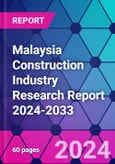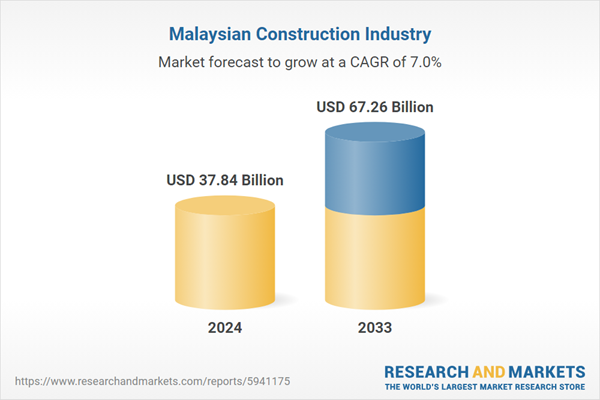In any country, the construction industry is significant, serving as a pillar of the economy while having a direct impact on the quality of life and urban landscape. According to the publisher, the industry's prosperity often reflects the nation's economic health and stage of development. In addition, its growth influences other sectors such as real estate, manufacturing, and finance, and thus has an impact on the broader economy. Therefore, the construction industry typically occupies a prominent position and exerts considerable influence within a country.
The construction market in Malaysia is divided into six sectors, namely Commercial Construction, Industrial Construction, Infrastructure Construction, Energy and Utilities Construction, Institutional Construction and Residential Construction. In 2023, the infrastructure construction sector accounted for the highest market share, followed by residential construction.
Strengths of Malaysian construction sector are attributed by capabilities of Malaysian construction companies to implement projects namely construction of buildings, roads and highways, railways, bridges and airports, water treatment and power plants; steel structure fabrication, installation and erection; mixed development projects including housing, hotels, leisure and luxury residences; and building maintenance, including for high-rise towers.
The steady growth of the Malaysian economy has provided a solid foundation for the expansion of the construction industry. Economic growth has driven demand for residential, commercial and industrial buildings as well as increased investment in infrastructure projects. The Malaysian government has played an important role in promoting the construction industry by stimulating the economy through the implementation of various construction projects and infrastructure programs such as the construction of roads, bridges and public transportation systems. In addition, the government has also introduced social welfare programs such as low-cost housing schemes, further boosting the demand for the construction sector.
Malaysia's construction industry has attracted significant FDI, particularly in the real estate and commercial construction sectors. Foreign investors are optimistic about Malaysia's high growth potential and strategic position, which has boosted the construction sector.
In 2023, the Malaysia construction market size was estimated at USD 35.5 billion. According to the publisher's analysis, the Malaysia construction market size is expected to reach 67.3 billion USD in 2033, growing at a CAGR of 6.6%. Although the Malaysian construction industry will face the challenges of lack of skilled labor and lax regulation, it will continue to grow in the future with the support of government policies and advanced technology.
Topics covered:
- Malaysia Construction Industry Overview
- The economic and policy environment of the construction industry in Malaysia
- Malaysia construction industry market size, 2024-2033
- Analysis of major Malaysia construction industry manufacturers
- Key Drivers and Market Opportunities in Malaysia's Construction Industry
- What are the key drivers, challenges and opportunities for the construction industry in Malaysia during the forecast period 2024-2033?
- Which companies are the key players in the Malaysia construction industry market and what are their competitive advantages?
- What is the expected revenue of Malaysia construction industry market during the forecast period of 2024-2033?
- What are the strategies adopted by the key players in the market to increase their market share in the industry?
- Which segment of the Malaysia construction industry market is expected to dominate the market in 2032?
- What are the main negative factors facing the construction industry in Malaysia?
Table of Contents
Companies Mentioned
- Gamuda Berhad
- IJM Corporation Berhad
- YTL Corporation Berhad
- WCT Holdings Berhad
- Malaysian Resources Corporation Berhad
- Gadang Holdings Berhad
- Hock Seng Lee Berhad (HSL)
- Mudajaya Group Berhad
- Muhibbah Engineering (M) Bhd
- Sunway Construction Group Berhad
Methodology
Background research defines the range of products and industries, which proposes the key points of the research. Proper classification will help clients understand the industry and products in the report.
Secondhand material research is a necessary way to push the project into fast progress. The analyst always chooses the data source carefully. Most secondhand data they quote is sourced from an authority in a specific industry or public data source from governments, industrial associations, etc. For some new or niche fields, they also "double-check" data sources and logics before they show them to clients.
Primary research is the key to solve questions, which largely influence the research outputs. The analyst may use methods like mathematics, logical reasoning, scenario thinking, to confirm key data and make the data credible.
The data model is an important analysis method. Calculating through data models with different factors weights can guarantee the outputs objective.
The analyst optimizes the following methods and steps in executing research projects and also forms many special information gathering and processing methods.
1. Analyze the life cycle of the industry to understand the development phase and space.
2. Grasp the key indexes evaluating the market to position clients in the market and formulate development plans
3. Economic, political, social and cultural factors
4. Competitors like a mirror that reflects the overall market and also market differences.
5. Inside and outside the industry, upstream and downstream of the industry chain, show inner competitions
6. Proper estimation of the future is good guidance for strategic planning.

LOADING...
Table Information
| Report Attribute | Details |
|---|---|
| No. of Pages | 60 |
| Published | February 2024 |
| Forecast Period | 2024 - 2033 |
| Estimated Market Value ( USD | $ 37.84 Billion |
| Forecasted Market Value ( USD | $ 67.26 Billion |
| Compound Annual Growth Rate | 7.0% |
| Regions Covered | Malaysia |
| No. of Companies Mentioned | 10 |









